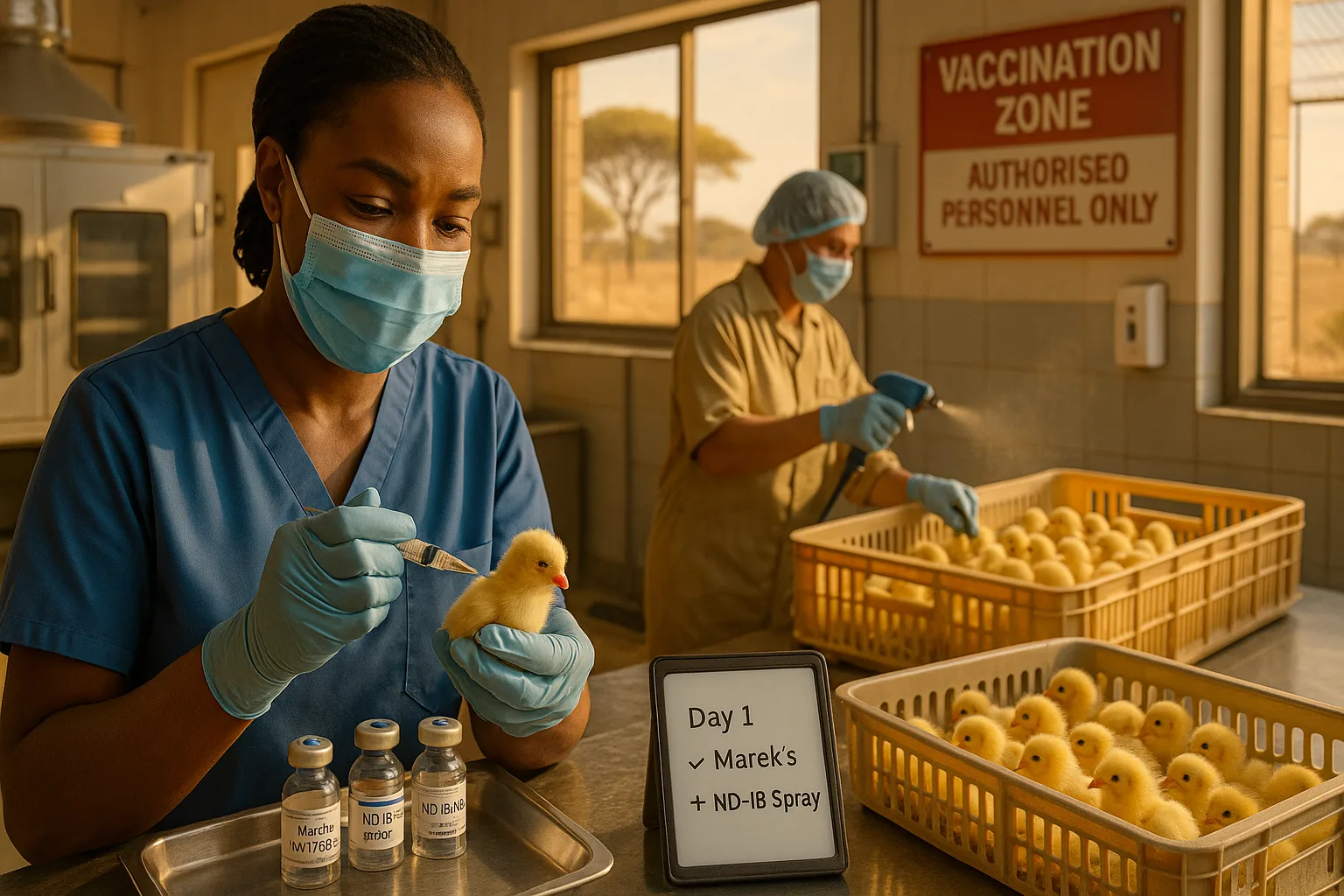Comprehensive Chicken Vaccination Schedule for South Africa

South Africa’s poultry industry faces significant threats from Newcastle Disease (ND), Infectious Bursal Disease (Gumboro), Avian Influenza (HPAI), and other pathogens. A disciplined vaccination program is critical to protect flocks, ensure productivity, and meet export standards. Below is the industry-standard schedule, aligned with guidelines from the South African Poultry Association (SAPA) and the Department of Agriculture, Land Reform and Rural Development (DALRRD).
I. Core Vaccination Schedule (Day 1 to 20 Weeks)
For all chickens (adjust under veterinary guidance based on regional risks)
| Age | Disease | Vaccine | Administration |
|---|---|---|---|
| Day 1 | Marek’s Disease | HVT/SB1 | Subcutaneous (neck) |
| Newcastle + Bronchitis | ND-IB Hitchner B1 | Spray | |
| Day 7–14 | ND + IB + Mycoplasma | ND-IB-MG | Subcutaneous (0.1 ml) |
| Week 3 | Gumboro (IBD) | Intermediate Strain (e.g., D78) | Drinking water |
| Week 4 | Gumboro (IBD) | Intermediate Strain | Drinking water (booster) |
| Infectious Bronchitis (IB) | IB H120 | Drinking water | |
| Week 6 | Newcastle Disease (ND) | ND La Sota | Spray |
| Week 8 | Fowl Pox | Live Pox Vaccine | Wing-web stab |
| Deworming | Levamisole/Ivermectin | Drinking water | |
| Week 12 | Infectious Laryngotracheitis | Live ILT Vaccine | Eye drop |
| Week 14 | Newcastle + Bronchitis | ND-IB Hitchner B1 | Spray (booster) |
| Deworming | Levamisole | Drinking water |
II. Breeder & Layer-Specific Boosters (Post-20 Weeks
Essential for maintaining egg production & chick immunity
| Frequency | Disease | Vaccine | Administration |
|---|---|---|---|
| Monthly | Newcastle Disease (ND) | ND La Sota | Spray |
| Quarterly | Deworming | Broad-spectrum antiparasitic | Drinking water |
| Biannual | ND + IB + Mycoplasma | ND-IB-MG | Subcutaneous (0.5 ml) |
| Annual | Fowl Pox | Pox Vaccine | Wing-web stab |
| Reovirus/EDS | Inactivated Reo/EDS | Injection |
III. HPAI Vaccination Strategy (2025 National Rollout)
Emergency response to H5N1/H7N6 outbreaks
Key Components
- Approved Vaccines:
- H5 Vaccines: 3 registered products (e.g., Vaxxitek H5+IBD).
- H7 Vaccine: Under development (expected late 2025).
- Priority Allocation:
- Commercial breeder flocks first (e.g., Astral Foods).
- Phased rollout to small-scale farmers (register via DALRRD).
- Four-Pillar Framework:
- Vaccine Control: State-regulated distribution.
- Biosecurity: Audits for hygiene, isolation, and pest control.
- Traceability: RFID tags & digital flock records.
- Surveillance: Weekly PCR testing for viral mutations.
Controversies & Challenges
- Trade Bans: Neighbouring states (Botswana, Namibia) prohibit imports from vaccinated flocks.
- Mutation Risks: “Leaky vaccines” may promote undetected viral spread (per ACDP/CDC warnings).
IV. Critical Best Practices
- Biosecurity First:
- Isolate new birds for 2 weeks.
- Disinfect footwear/vehicles entering farms.
- Control rodents & wild birds.
- Vaccine Protocols:
- Store vaccines at 2–8°C (never freeze).
- Use vaccines within 2 hours of reconstitution.
- Record batch numbers, dates, and bird reactions.
- Legal Compliance:
- Report HPAI symptoms immediately to SAPA (086 111 7282).
- Use only registered vaccines – unapproved products incur fines.
Conclusion
South Africa’s vaccination framework balances routine protection against endemic diseases (ND, Gumboro, IB) with emergency HPAI measures. While vaccines reduce mortality, they work best alongside rigorous biosecurity. Consult your veterinarian to tailor schedules to local disease pressures, and monitor SAPA/DALRRD for real-time updates.
Resources: